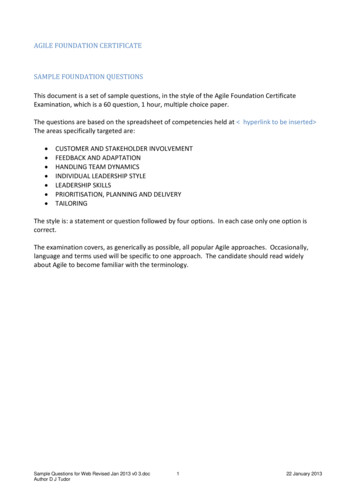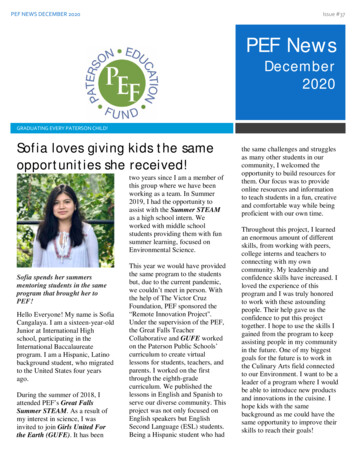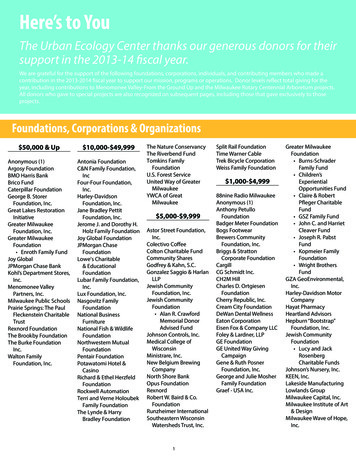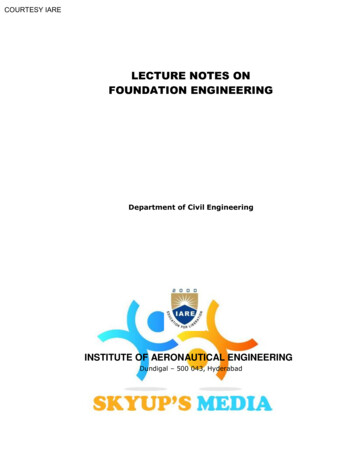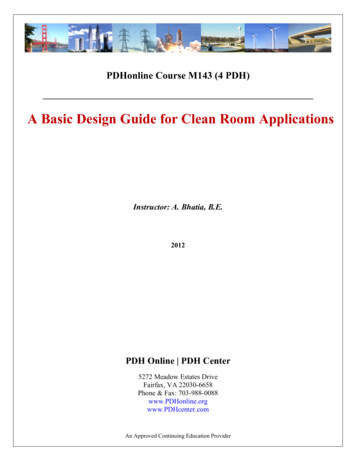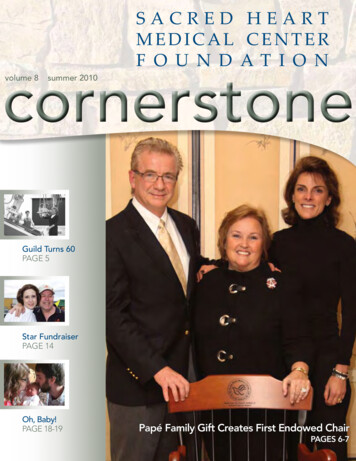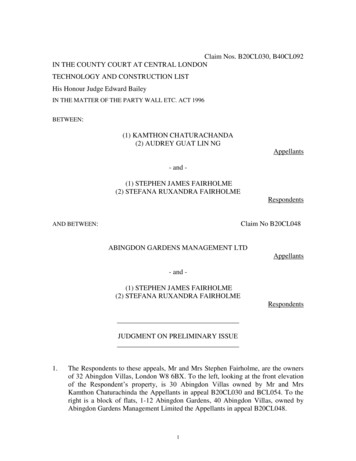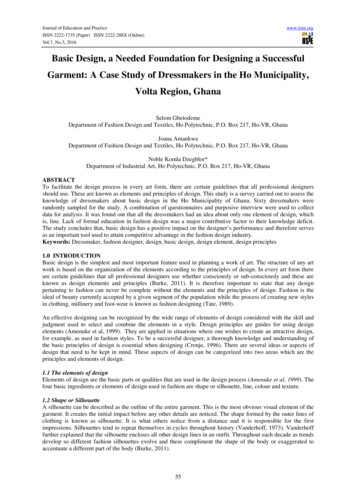
Transcription
Journal of Education and PracticeISSN 2222-1735 (Paper) ISSN 2222-288X (Online)Vol.7, No.3, 2016www.iiste.orgBasic Design, a Needed Foundation for Designing a SuccessfulGarment: A Case Study of Dressmakers in the Ho Municipality,Volta Region, GhanaSelom GbetodemeDepartment of Fashion Design and Textiles, Ho Polytechnic, P.O. Box 217, Ho-VR, GhanaJoana AmankwaDepartment of Fashion Design and Textiles, Ho Polytechnic, P.O. Box 217, Ho-VR, GhanaNoble Komla Dzegblor*Department of Industrial Art, Ho Polytechnic, P.O. Box 217, Ho-VR, GhanaABSTRACTTo facilitate the design process in every art form, there are certain guidelines that all professional designersshould use. These are known as elements and principles of design. This study is a survey carried out to assess theknowledge of dressmakers about basic design in the Ho Municipality of Ghana. Sixty dressmakers wererandomly sampled for the study. A combination of questionnaires and purposive interview were used to collectdata for analysis. It was found out that all the dressmakers had an idea about only one element of design, whichis, line. Lack of formal education in fashion design was a major contributive factor to their knowledge deficit.The study concludes that, basic design has a positive impact on the designer’s performance and therefore servesas an important tool used to attain competitive advantage in the fashion design industry.Keywords: Dressmaker, fashion designer, design, basic design, design element, design principles1.0 INTRODUCTIONBasic design is the simplest and most important feature used in planning a work of art. The structure of any artwork is based on the organization of the elements according to the principles of design. In every art form thereare certain guidelines that all professional designers use whether consciously or sub-consciously and these areknown as design elements and principles (Burke, 2011). It is therefore important to state that any designpertaining to fashion can never be complete without the elements and the principles of design. Fashion is theideal of beauty currently accepted by a given segment of the population while the process of creating new stylesin clothing, millinery and foot-wear is known as fashion designing (Tate, 1989).An effective designing can be recognized by the wide range of elements of design considered with the skill andjudgment used to select and combine the elements in a style. Design principles are guides for using designelements (Amenuke et al, 1999). They are applied in situations where one wishes to create an attractive design,for example, as used in fashion styles. To be a successful designer, a thorough knowledge and understanding ofthe basic principles of design is essential when designing (Cronje, 1996). There are several ideas or aspects ofdesign that need to be kept in mind. These aspects of design can be categorized into two areas which are theprinciples and elements of design.1.1 The elements of designElements of design are the basic parts or qualities that are used in the design process (Amenuke et al, 1999). Thefour basic ingredients or elements of design used in fashion are shape or silhouette, line, colour and texture.1.2 Shape or SilhouetteA silhouette can be described as the outline of the entire garment. This is the most obvious visual element of thegarment. It creates the initial impact before any other details are noticed. The shape formed by the outer lines ofclothing is known as silhouette. It is what others notice from a distance and it is responsible for the firstimpressions. Silhouettes tend to repeat themselves in cycles throughout history (Vanderhoff, 1973). Vanderhofffurther explained that the silhouette encloses all other design lines in an outfit. Throughout each decade as trendsdevelop so different fashion silhouettes evolve and these compliment the shape of the body or exaggerated toaccentuate a different part of the body (Burke, 2011).55
Journal of Education and PracticeISSN 2222-1735 (Paper) ISSN 2222-288X (Online)Vol.7, No.3, 2016www.iiste.org1.3 LinesLine refers to edge or the outline of a garment and the style line that divide the space within a garment. Line cancreate visual illusion if used skillfully (Tate, 1998). Line is the simplest and the most important of the designelements. All lines have length and width (Manmeet, 2008). Basically, straight and curved lines are used indesigning styles for clothing. A straight line can be vertical, horizontal or diagonal. According to Vanderhoff,lines have direction, width, and length. Direction can be vertical, horizontal, diagonal or curved, movement ofthe eye of an observer around and through an image (Nateman, 1994). It is important to understand that linescreate illusions or images. The design line of a garment, helps the viewer’s eyes to follow a certain direction.These lines can be cleverly used to improve body shapes and proportions. The line of a garment relates to its cutand style lines: its construction. These lines break up the space within the outline of the garment and createshape, the seam lines, the darts, pleats, tucks (Burke, 2011). Vertical lines tend to lengthen the body and make itappear slimmer.A diagonal line normally slants from one side to the other and it tends to increase or decrease in width, heightand the direction to the height of the figure. If it is fairly short and fairly sharp, it decreases the width. If it isfairly flat it adds width to the top of the figure. Examples of diagonal lines used in fashion designing are: flaredskirts, jacket, lapel collar, neckline, bell-bottom trousers, yokes, cowl-neck, etc. Curved lines vary from gentlecurves to full rounded and twisted lines. Tate (2003) states that a gentle curve is feminine. Vanderhoff confirmedthe above by saying that curved lines tend to add softness and femininity to a design. A curved line that iscontrolled is gentle, flowing and graceful. Curved lines may be used decoratively such as scalloped edges. Indesigning, high curves suggest greater height than lower curves. Basically, curved lines are either rounded orsomewhat flattened out. The flattened out curves are often considered more flattering to the human shape thanrounded lines. A curved line also adds fullness and roundness in a design sketch, when it is used in illustratingfolds or gathers (Vanderhoff).The structural lines of a garment give it shape and help to form the silhonette. Structural lines are made bysewing together the parts of a garment. Seams and darts are structural lines because they shape the garment. Agarment can sometimes be cut in certain places to make a special seam. This seam is still considered a structuredline. Design or decorative lines on the other hand are those that are added simply to create a decorative element.They are never structural lines even though some structural lines are sometimes design lines which include suchdetails as the placement of several buttons in a line, top stitching or the placement of a pocket or flap. Designand structural lines can be used to enhance the body shape. The more elaborate the lines are, the more attentionthey draw to the body. Large bold lines make the figure look larger than it actually is. E.g. a decorated rolledcollar framing a beautiful face might divert the eye from a heavy hip (Vanderhoff).1.4 TextureTexture is the characteristic structure as well as the surface quality of a material (Manmeet, 2008). Texturedescribes the perceived quality of a surface whether real or simulated (Nateman, 1994). The texture of a fabricappeals to the eyes as well as the sense of touch. Texture refers to the surface appearance and feel of a fabric.This results from the type of raw material and the type of weave used in producing the fabric (Vanderhoff). Thetexture of a fabric may be described as soft, rough, shiny, dull, bulky, filmy, transparent, thick and smooth.Design and texture are closely related in that, at times the design of the weave determines the texture. The degreeof stiffness or softness and the weight of the fabric will influence the drape, which is the way it hangs on thefigure. Drape is an important factor which determines how well a particular fabric will move with the body andmaintain the shape of the style. The soft handle of a fabric is suitable for a garment with draped or flowingfeatures and a stiff fabric is suitable for a tailored style. The sheen of fabrics such as sateen, make them moresuitable for evening wear than any daytime wear because such fabrics reflect more light during the day thannight due to their smoothness (Vanderhoff).The quality or texture of a material can alter the tone of its colour. A rough surface may affect the apparentcolour of an object. Very smooth and shiny surfaces attract attention because of the amount of light they reflect.On the other hand, very rough textures have small projections that cast shadows in the light. These shadowsmake the colour seem darker. An identical colure in two fabrics with different textures may not look the same.E.g., boucle fabric will look darker than a piece of cotton-lawn fabric dyed the same colour. Pile weave fabricgives richness and depth to the shade of colour of the fabric due to its structure and texture.Texture can create illusions to the figure of the wearer, a shiny fabric such as satin appears to increase size andthus, makes figures look larger than they are. It also emphasizes figure faults or defects therefore; it is notsuitable for heavy persons. Glossy texture also makes a slender figure look smaller. On the other hand,56
Journal of Education and PracticeISSN 2222-1735 (Paper) ISSN 2222-288X (Online)Vol.7, No.3, 2016www.iiste.orgmaterials with matt surfaces such as crepes and woolen fabrics have the reverse effect. Heavy, bulky texturessuch as tweed add bulk to the figure and therefore make the short heavy person look fatter and shorter. Stiffmaterials which are rigid in texture stand away from the figure, adding more width. Thus, they make a slimfigure look broader than the actual size (Manmeet, 2008).1.5 Colour in fashion designingColour creates the most visual impact when seen from a distance, it is the most influential element thatcontribute to the overall nature of the garment. (Burke, 2011). There are no fixed rules about flattering colour.Colour has personal values therefore personal preferences for certain colours will affect an individual’s choice. Itis possible to wear all colours if one knows how to use them wisely. Colour can affect and reflect the way peoplefeel. Warm colours such as bright red, oranges and purples are stimulating and exciting colours which can makepeople feel happy (Faiola, et al, 1982). Soft colours such as blues, greens and white suggest coolness andcalmness. Black and greys have a depressing effect.1.6 Principles of design in fashionAccording to Vanderhoff, the aim of fashion design is to choose the principles of design as a guide to theapplication of the elements. This means that the principles help the designer to understand how the elements ofdesign should be used in creating suitable designs in order to achieve the goals of clothing. Tate (1989) statedsome of the goals of fashion as: to achieve a clothing that is comfortable to wear; to achieve a pleasantappearance of individual; to emphasize good points and minimize the bad points on the figure known as figurefaults. The principles of design are: unity, balance, rhythm, repetition, emphasis, proportion and scale(Vanderhoff, Tate). These are applied when one wants to create an aesthetically attractive design. Aestheticinvolve the three-dimensional rules of construction called the elements and principles of design. The principlesof design are the rules that govern how these elements are combined (Tate).1.7 BalanceBalance in a design may be either formal or informal. Formal balance is also known as symmetrical balance orequal balance. In organization, designs which look the same on both sides of a garment, have a formal balance orsymmetrical balance. Symmetric balance places style lines and details evenly on the garment (Burke).Plate 1: Principle of balancePlate 2: Asymmetric BalanceIn a balanced design, the weight of different elements of the design is equally distributed to create balance. Thisgives stability to the whole design. When the various parts of the design for example colour, texture, line andmotif in the fabric have been arranged so that the feeling of equilibrium results, it is a formal design. This is sowhen the design is the same on either side of the centre (left) as shown in Plate 1. A feeling of balance is also57
Journal of Education and PracticeISSN 2222-1735 (Paper) ISSN 2222-288X (Online)Vol.7, No.3, 2016www.iiste.orgproduced when large areas of tint are equalized by small areas of either bright colour or shades (right) asindicated in Plate 1 (Manmeet, 2008).Informal or asymmetrical balance means unequal balance. This means that though each side of the design isequally interesting or important it does not look exactly like the other side of the design it involves placement ofobjects in a way that will allow objects of varying visual weight to balance one another around a fulcrum point.(Mazumder, 2011) To achieve a more exciting dramatic effect asymmetrical balance can be used. An example isthe one shouldered dress and the dress (left) with a slanted hem (right) in Plate 2.Plate 3: Principles of emphasisPlate 4: Principle of rhythmAnother principle of design is emphasis. Something that is singled out or made more prominent has emphasis.An element of a design that dominates or becomes the centre of interest has emphasis. A highlight in a design isan emphasis in that design. It is the centre of interest because it predominates over the rest of the design.Emphasis can be created by contrasting texture, colour, lines, dots, or by using an unusual shape sewn onto thegarment in the form of appliqué as shown in Plate 3 (left) or fringes (right) respectively.1.8 RhythmA design has rhythm when the line, colour and texture have been arranged in an orderly way so that one’s eyesmoves easily from one part of the design to another. A pleasing rhythm holds a design together the curved edgeof a repetition of colour may also be used to create rhythm in either a dress as in Plate 4 (right). Repetition ofcolour in the three tier flare at the hem of the garment in Plate 4 (left) creates rhythm. By the regular repetitionof design features such as curves, texture, lines and colour, rhythm is created. In Plate 4 (right), the repetition ofgathered strips of fabric sewn on the slit also creates a rhythm.58
Journal of Education and PracticeISSN 2222-1735 (Paper) ISSN 2222-288X (Online)Vol.7, No.3, 2016www.iiste.orgPlate 5: Rhythm by gradation and radiationPlate 6: Unity of shapes colourRhythm by radiation is created in a dress when lines flow from a centre of interest, as shown in Pate 5 (right)where gathering is made by an inserted ring, at the centre front of the blouse. The gathering attracts one’s eyesto the movement of the lines in the design. Plate 6 is an example of rhythm by radiation. Rhythm by gradation(progressive rhythm) is achieved by increasing or decreasing the size of elements such as shape, line and colouras they are repeated. In Plate 5 (left) the appliqué in the dress decreases in size towards the hem of the garment.It can be very effective in creating interest in a garment.1.9 UnityA design is said to have unity if all the design elements and principles work together to produce a pleasing effect.For example, unity of line is important to a pleasing appearance, as in Plate 5 (left), where curved lines are usedfor the neckline, the pockets tabs and the hem of the jacket. When lines are properly unified the design lookscomplete. Again, when colour is repeated in a dress it unifies the design as in Plate 5 (right).2.0 METHODOLOGYThe design used in this research is the mixed type; quantitative and qualitative. The research methodologyadopted is descriptive survey through which views were sampled from 60 respondents. The criterion of selectionis based on dressmakers’ experience of at least 5 years of continuous work. The descriptive survey was used indiscovering the current state of affairs as regards dressmaking. This method permitted the researchers to gatherinformation from a reasonable number of people in a relatively quick and inexpensive way. The simple randomsampling method was used and the data gathering tools used were questionnaire and interview. The formal andinformal interview schedules were employed by way of structured interview surveys. The target populationincludes dressmakers within the Ho Municipality while the accessible population covered sixty dressmakers. Therespondents were interviewed and questionnaires administered to them at random at their workshops.3.0 RESULTS AND DISCUSSIONSThe data collected is based on the application of basic design in sewing by dressmakers. The main focus was thenumber of years dressmakers have served in the sewing industry in relation to their knowledge in basic designusing the elements and principles of design; sources of styles chosen by clients and their effects on dressmaking;and knowledge about human figure types.59
Journal of Education and PracticeISSN 2222-1735 (Paper) ISSN 2222-288X (Online)Vol.7, No.3, 2016www.iiste.orgTable 1: Number of years in the sewing businessYear5 - 10 years11 - 15 years16 - 20 yearsAbove yearsTotalFrequency1512211260Percentage (%)25203520100Source: Field dataTable 1 highlights the working experience of respondents. The working experience of the 60 respondentsrevealed that as many as 55% have been working for over 16 years and only 5% have little knowledge about theuse of lines. In relating their working experience to the knowledge of basic design, it is evident that theapplication of the elements and the principles to sewing was not dependent on the number of years in thebusiness. The reality is that only 2% had some knowledge about principles of designing out of the 25% whohave been working between 5 - 10 years.Table 2: Sources of styles chosen by clientsSourceCatalogueCalendarFrom what people wearBy describing itTotalFrequency1512211260Percentage (%)25203520100Source: Field dataTable 2 reflects the sources of styles chosen by clients. It is clear that majority, that is, 33 representing 55% gettheir styles or ideas from what people wear and by way of description. On the other hand, a total of 27respondents representing 45% stated that styles chosen by clients are from the catalogue or calendar. It isobvious that the dressmakers do not have too much to say about the choice of styles by their clients. The choiceof the customer is paramount, thus, stressing the point that the dressmakers have no idea about suitable styles foreach figure type. It is apparent to conclude that respondents cannot impress or force their customers to select aparticular style for sewing.Table 3: Knowledge about human figure typesResponseYesNoTotalFrequency124860Percentage (%)2080100Source: Field dataTable 3 indicates that 12 respondents who represent 20% have just a slight idea about human figure types.Specifically, they stated that they know about fat, tall and short figures only. On the other hand 48 or 80%signifying the majority had no idea.60
Journal of Education and PracticeISSN 2222-1735 (Paper) ISSN 2222-288X (Online)Vol.7, No.3, 2016www.iiste.orgTable 3: Choice of fabric for figure typesChoice of fabricAbility to choose fabricsInability to choose fabricsTotalFrequency243660Percentage (%)4060100Source: Field dataIn the case of the choice of fabric for figure types, respondents asserted categorically that they do not choose thefabric colours but the customers do by opting for colours that appeal to them. On the part of the respondents,40% of affirmed that they are capable of choosing suitable plain coloured fabrics to match styles which demanda combination with plain coloured fabrics. However, majority representing 60% indicated that they do not knowmuch about relating colour in the patterned fabric with a plain coloured combination. They stated their handicapas their inability to identify related colours and that they have never had any form of education in colour. Inconfirmation, majority forming 90% of the respondents are (semi illiterates) this means they had formaleducation up to the basic level.CONCLUSIONThe study concluded that the knowledge about basic design has a positive impact on the styles the designerproduces for each figure types. When this knowledge is applied, styles fit very well and enhance the image of thewearer. Basic design therefore serves as a tool that would help the dressmaker who applies it, to havecompetitive advantage in skill development over others who have no such knowledge in the fashion industry.Secondly, dressmakers in the Ho Municipality have no formal education on figure types or basic design duringtheir apprenticeship period. It is clear that they have no idea about suitable styles for each figure type. The factthat the dressmakers have been engaged in sewing for a number of years does not mean they have knowledgeabout basic design, that is, the effective use of the elements and the principles of design.The study therefore recommends that, a series of workshops and seminars be organized for dressmakers on theuse of basic design in choosing suitable styles for their clients. Again, knowledge in basic design will help dressmakers to select plain or coloured fabrics to match other patterned or textured fabrics. Also, the dressmakersneed to know about the different figure types, in order to help clients to choose suitable styles.REFERENCESAmenuke, S.K., Dogbe, B.K., Asare, F.D.K., Ayiku, R.K. & Baffoe, A. (1991). General Knowledge in Art forSenior Secondary Schools. Accra: Ministry of Education.Ampong, I. and Gavor, M. A. (1992). Clothing and Textiles for Senior Secondary Schools. Hong Kong: Ministryof Education, Longman (FE) Ltd.Bear, Jacci. "Focus on This: Emphasis and the Principles and Elements of Design." About Technology. Web. 17Sept. 2014.Burke, S. (2011). Fashion Designer, concept to collection. United Kingdom: Burke -Collection-Sandra-Burke/dp/Crongé, A. (1996). Study Guide, Drawing and Illustration Department of Fashion Design and Technology.Pretoria: Technicon.Faiola T. and Jo A. P. (1982). The McGraw-Hill Guide to Clothing. New York: McGraw-Hill, Inc.Harold Carr, Fashion Design and Product Development, Longman UK. 1973 Pp. 88-89.Manmeet S. (2008). Design Studies. New Delhi India: Kalyani PublishersMazumder P. S. (2011). Principles of Design. Retrieved July 15, 2014. Website:http://www.fashiondesignscope.comNateman, D. (1994). Introduction to Art. U.S.A.: Mc Graw-Hill Inc.Reader’s Digest Step-by-Step Guide, Sewing and Knitting, Reader’s Digest (Australia) Pty Ltd. 1993, pp.48-55.Tate. S. L (1989). Inside fashion design (3rd FH) New York: HarperCollins Publishers.Vanderhoff, M. (1973). Textiles for homes and people. Lexington: Ginn and Co.61
Design and texture are closely related in that, at times the design of the weave determines the texture. The degree of stiffness or softness and the weight of the fabric will influence the drape, which is the way it hangs on the figure. Drape is an important factor which determines how well a particular fabric will move with the body andFile Size: 2MB

